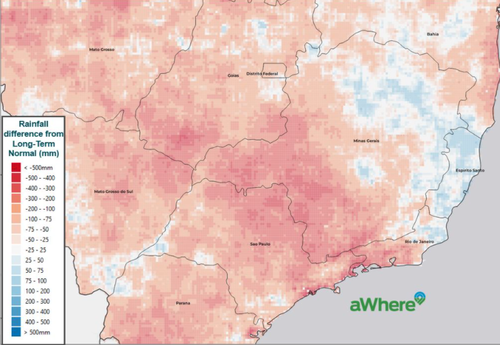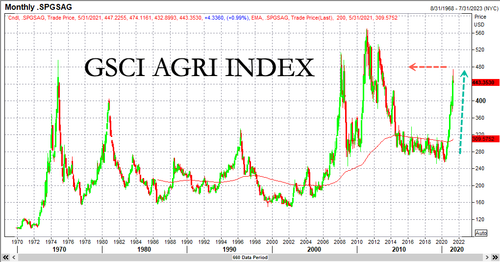La Nina Turbocharges Drought In Brazil Putting World’s Coffee, Sugar, & Oranges At Risk
ZeroHedge.com
Global crop and food prices are skyrocketing to multi-year highs, and the culprit could be due to La Nina, a weather pattern characterized by the cooling of the equatorial Pacific and triggers atmospheric shifts that cause droughts in some regions of the world and wetter conditions in others. The prospect of a severe drought in the US has already be outlined in previous notes. Now it appears the worst drought in 20 years has struck agricultural rich Brazil.
Over the last month, Brazil has been faced with drought during its traditional rainy season.
“Soils are parched, and river levels are low in the nation’s Center-South region, a powerhouse of agricultural output. The drought is so severe that farmers are worried they’ll run out of the water reserves that help keep crops alive over the next several months, the country’s dry season,” said Bloomberg.
The cost of this year’s drought could severely impact coffee, sugar, and orange crop yields.
Coffee farmer Mauricio Pinheiro, 59, began irrigating his arabica-coffee crops in March, more than two months earlier than usual after his 131-acre farm received only half the rain it needed. He’s using so much water that his wells are running dry.
“My irrigation reservoir is drying up now — that usually happens in August,” said Pinheiro, who resides in Pedregulho in the Alta Mogiana region, in Sao Paulo state. “I’m concerned about running out of water in the coming months.”
One of the worst droughts to hit the country in decades is coming at a time when agricultural prices have rallied to multi-year highs, fanning fears of food inflation.
As much as the Federal Reserve is hoping for “transitory” inflation – La Nina altering weather patterns could exacerbate food inflation and make the problem global and last for years.
Brazil’s coffee and orange crop are likely to decline for the second consecutive year. Brazil’s current orange crop contracted 31% from the previous season, the most in three decades, and production of arabica coffee is also falling. Arabica coffee is used at Starbucks Corp and other fancy coffee chains, which means the cost of coffee is going up.
John Corbett, Chief Executive Officer at agriculture tech company aWhere Inc., said, “rainfall was disastrously low for many areas in Sao Paulo and Minas Gerais from January to April.” He said these worst-hit areas received less than half of average precipitation during the rainy season.
“Water reservoirs are drying up, depleted just ahead of the dry season,” Gilberto Tozatti, of Sao Paulo-based GCONCI-Group Citrus Consulting, said by phone. “The situation is affecting most of Sao Paulo state and still harming next season’s crop.”
The drought is also affecting neighboring Argentina and Paraguay. River levels are quickly dropping, forcing barges, carrying farm goods to reduce capacities to avoid grounding. These lighter barge loads have decreased the flow of corn, soybeans, soybean meal, and soybean oil to key export locations.
La Nina strikes again, suggesting the Fed’s “transitory” narrative, for at least food, might not be the case, and higher prices could extend well into 2022.
___
https://www.zerohedge.com/commodities/la-nina-turbocharges-drought-brazil-worlds-oranges-coffee-risk


